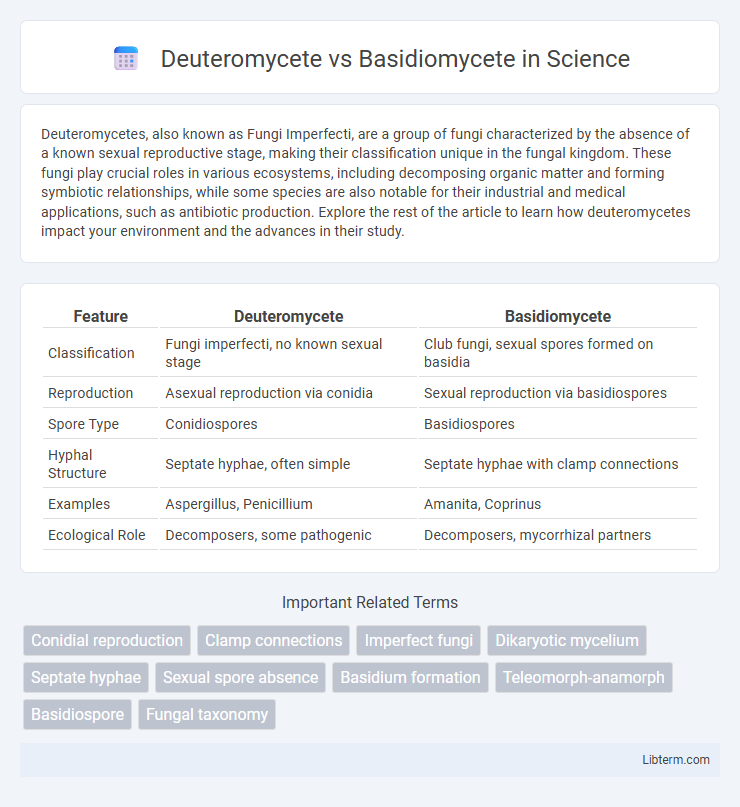Deuteromycetes, also known as Fungi Imperfecti, are a group of fungi characterized by the absence of a known sexual reproductive stage, making their classification unique in the fungal kingdom. These fungi play crucial roles in various ecosystems, including decomposing organic matter and forming symbiotic relationships, while some species are also notable for their industrial and medical applications, such as antibiotic production. Explore the rest of the article to learn how deuteromycetes impact your environment and the advances in their study.
Table of Comparison
| Feature | Deuteromycete | Basidiomycete |
|---|---|---|
| Classification | Fungi imperfecti, no known sexual stage | Club fungi, sexual spores formed on basidia |
| Reproduction | Asexual reproduction via conidia | Sexual reproduction via basidiospores |
| Spore Type | Conidiospores | Basidiospores |
| Hyphal Structure | Septate hyphae, often simple | Septate hyphae with clamp connections |
| Examples | Aspergillus, Penicillium | Amanita, Coprinus |
| Ecological Role | Decomposers, some pathogenic | Decomposers, mycorrhizal partners |
Introduction to Fungal Classification
Deuteromycetes, also known as fungi imperfecti, are characterized by the absence of a known sexual reproductive stage, distinguishing them from Basidiomycetes, which produce sexual spores on basidia. Basidiomycetes include familiar mushrooms, rusts, and smuts, playing essential roles in decomposition and symbiotic relationships. Understanding these classifications helps clarify fungal diversity and life cycle complexity within the kingdom Fungi.
Overview of Deuteromycetes
Deuteromycetes, also known as Fungi Imperfecti, represent a diverse group of fungi primarily characterized by the absence of a known sexual reproduction stage, contrasting with Basidiomycetes that reproduce sexually through basidia. This group encompasses numerous species with asexual reproduction via conidia, playing critical roles in decomposition, antibiotic production, and as plant pathogens. Their classification remains complex due to the lack of sexual structures, often relying on molecular analysis for identification and linking them to sexual counterparts within Ascomycota or Basidiomycota divisions.
Overview of Basidiomycetes
Basidiomycetes, a major class of fungi within the phylum Basidiomycota, are characterized by producing spores on specialized cells called basidia. These fungi play crucial ecological roles as decomposers, symbionts, and pathogens, with notable examples including mushrooms, puffballs, and shelf fungi. Unlike Deuteromycetes, which are primarily asexual and lack a known sexual stage, Basidiomycetes possess a complex sexual reproductive cycle involving basidiospores.
Key Morphological Differences
Deuteromycetes, also known as fungi imperfecti, lack a sexual reproductive stage and primarily reproduce asexually through conidia, resulting in variable morphological forms like septate hyphae and diverse conidial structures. Basidiomycetes are characterized by the presence of basidia, where sexual reproduction occurs, producing basidiospores typically arranged on gills or pores, and exhibit complex fruiting bodies such as mushrooms, brackets, or puffballs. The cell walls of basidiomycetes often contain chitin, and they possess clamp connections on hyphae, which are absent in deuteromycetes, marking a significant morphological distinction.
Reproductive Strategies and Structures
Deuteromycetes reproduce primarily through asexual spores called conidia, lacking a known sexual stage, which distinguishes them from Basidiomycetes that reproduce sexually via basidiospores formed on specialized structures called basidia. Basidiomycetes exhibit complex reproductive structures such as mushrooms, puffballs, and bracket fungi, facilitating spore dispersal and genetic recombination. The absence of sexual reproduction in Deuteromycetes results in a reliance on mitotic spore production, leading to genetic stability but limited diversity compared to the meiotic processes in Basidiomycetes.
Ecological Roles and Habitats
Deuteromycetes, often known as imperfect fungi, predominantly occupy soil and decaying organic matter where they play crucial roles in decomposition and nutrient cycling, supporting ecosystem balance. Basidiomycetes thrive in diverse habitats including forests and grasslands, serving as key decomposers of wood and leaf litter and forming mutualistic mycorrhizal associations that enhance plant nutrient uptake. Both groups contribute significantly to ecological processes, with basidiomycetes often dominating wood decay and Deuteromycetes influencing soil health and organic matter turnover.
Genetic and Molecular Distinctions
Deuteromycetes, often termed "imperfect fungi," lack a known sexual reproductive stage, causing their genetics to be studied primarily through asexual spores and molecular markers like ITS sequences. Basidiomycetes possess a well-characterized sexual cycle with basidiospores produced on basidia, featuring complex dikaryotic stages that contribute to their genetic diversity and mating type loci organization. Molecular distinctions include differences in gene families related to mating type genes, pheromone receptors, and conservations in ribosomal DNA, which are used to differentiate these two fungal groups at the genetic level.
Medical and Economic Importance
Deuteromycetes, often called imperfect fungi, are significant in medicine for producing antibiotics like penicillin and causing opportunistic infections such as aspergillosis. Basidiomycetes hold economic importance due to their role in cultivating edible mushrooms like Agaricus bisporus, and some species produce medically valuable compounds with potential anticancer properties. Both groups impact agriculture, with deuteromycetes contributing to plant diseases while basidiomycetes aid in wood decay and nutrient cycling.
Examples and Representative Species
Deuteromycetes, commonly known as imperfect fungi, include species like *Penicillium* and *Aspergillus*, which lack a known sexual reproductive stage. Basidiomycetes, or club fungi, encompass well-known representatives such as *Agaricus bisporus* (common mushroom), *Cryptococcus neoformans*, and *Puccinia graminis* (wheat rust pathogen). While Deuteromycetes are significant in antibiotic production and food spoilage, Basidiomycetes are crucial for their ecological role in decomposing wood and forming mycorrhizal relationships.
Conclusion: Comparing Deuteromycetes and Basidiomycetes
Deuteromycetes, also known as fungi imperfecti, lack a known sexual reproductive stage, while Basidiomycetes undergo sexual reproduction producing basidiospores on basidia. Basidiomycetes include mushrooms, puffballs, and shelf fungi, contributing significantly to nutrient cycling and wood decay; Deuteromycetes primarily consist of asexual molds important in food production and antibiotic synthesis. The differences in reproductive strategies and ecological roles highlight distinct evolutionary adaptations within these fungal groups.
Deuteromycete Infographic

 libterm.com
libterm.com